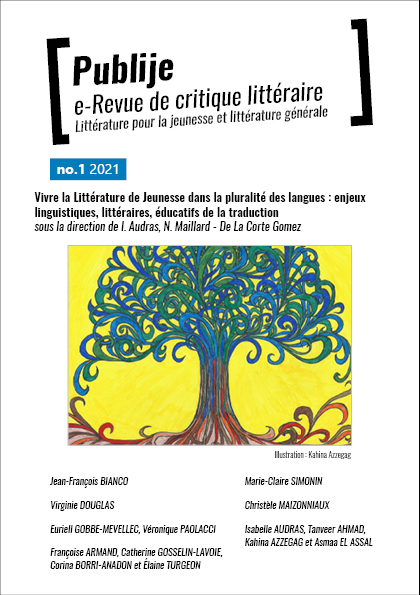De l’hybridation linguistique à la traduction : le cas Haroun and the Sea of Stories (1990) de Salman Rushdie
Mots-clés :
Salman Rushdie, Haroun and the Sea of Stories, Haroun et la mer des histoires, hybridation linguistique, plurilinguisme, traduction, postcolonialismeRésumé
Salman Rushdie, auteur britannique d’origine indienne, lauréat du prestigieux Booker Prize, n’a écrit que deux romans pour la jeunesse. Cet article se concentre sur le premier de ces récits, Haroun and the Sea of Stories (1990), et sur la traduction qu’en a donnée Jean- Michel Desbuis, Haroun et la mer des histoires (1991). Ce roman de fantasy destiné aux pré- adolescents, conte moderne saturé de références intertextuelles, a pour thèmes principaux la langue et le discours, des sujets alors en partie dictés par la situation de Rushdie puisque Haroun est le livre par lequel il renoue avec l’écriture après la fatwa lancée par l’ayatollah Khomeiny après la publication des Versets sataniques (1988). Au-delà de l’interprétation première de la langue et de la parole du conteur comme métaphores de la liberté d’expression et de l’inspiration littéraire, la cohabitation et la diversité des langues présentes dans le texte sont aussi le moyen d’une réflexion sur une pluralité linguistique et culturelle liée à l’exil qui traduit un déracinement autant qu’elle constitue une richesse. Par la dextérité linguistique et le plurilinguisme sur lesquels repose son style, Rushdie explore l’hybridité culturelle dont il est le produit. Le roman fait cohabiter et s’hybrider plusieurs langues et l’anglais y est imprégné d’hindi-ourdou, qui inspire le rythme répétitif de l’expression ainsi que la plupart des noms propres. Les échanges entre diverses langues et le processus de traduction sont donc déjà inscrits dans la diégèse de Haroun. Le plurilinguisme sert l’inventivité ludique et l’esthétique polyphonique du texte, mais son utilisation revêt également une dimension didactique. La traduction française de l’ouvrage se devait de conserver cette double vocation. Le glossaire est traduit dans la version française du texte et, comme dans la version originale, les termes hindi-ourdou y donnent lieu à des emprunts ; mais le métissage de la langue « dominante » par des indianismes et les langues européennes a été plus difficile à mettre en œuvre.
Salman Rushdie, a British Indian author and recipient of the prestigious Booker Prize, only wrote two children’s novels. This article focuses on the first of these narratives, Haroun and the Sea of Stories (1990) and its French translation by Jean-Michel Desbuis, Haroun et la mer des histoires (1991). The main themes of this fantasy novel for pre-teens, a modern fairy tale packed with intertextual references, are language and speech: such topics were consistent with Rushdie’s situation then, as Haroun was the book with which he started writing again after the fatwa issued by Ayatollah Khomeiny following the publication of The Satanic Verses (1988). Beyond the primary interpretation of the storyteller’s language and speech as metaphors of the freedom of speech and of literary inspiration, the cohabitation of the various languages present in the text is also a means to broach the issue of the linguistic and cultural plurality which relates to the experience of exile and brings about both uprootedness and vibrant diversity. Thanks to the linguistic craftsmanship and the plurilingualism of his style, Rushdie explores the cultural hybridity which produced him. In the novel several languages coexist and hybridise, and the English that is used is steeped in Hindi-Urdu: this accounts for the repetitive rhythm of the writing style as well as for most proper names. Thus, the exchanges between the different languages, and the process of translation are already enshrined in the diegesis in Haroun. Plurilingualism benefits the playful inventiveness and polyphonic aesthetics of the text, but it also assumes a didactic dimension. The French translation of the book had to maintain this two-fold purpose. The glossary is translated in the French version, and there are Hindi-Urdu loanwords in the translation as is the case in the original text. But crossing the “dominant” language with Indianisms and European languages has been more difficult to carry out.
Téléchargements
Publiée
Comment citer
Numéro
Rubrique
Licence
(c) Tous droits réservés Virginie Douglas 2021

Ce travail est disponible sous licence Creative Commons Attribution - Pas d'Utilisation Commerciale - Pas de Modification 4.0 International.
Les auteurs qui publient dans cette e-revue acceptent les termes suivants :
Les auteurs conservent le droit d'auteur et accordent à la revue le droit de première publication, sous la licence Licence d’attribution Creative Commons permettant à d'autres de partager les articles tout en en reconnaissant la paternité et la publication initiale dans cette revue.





